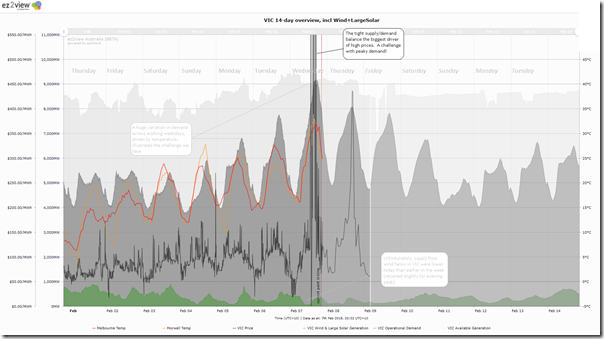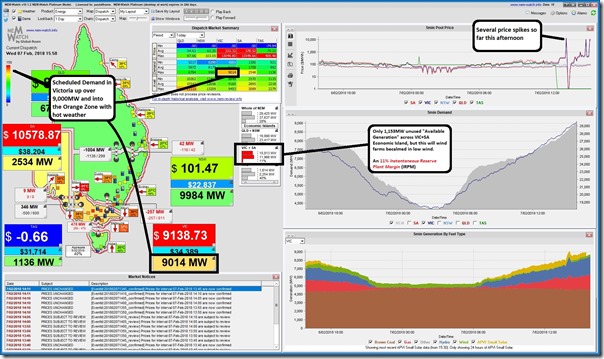A quick post to bookmark a day where Victorian demand (Scheduled, and Operational) peaked above 9,000MW and NEM-wide demand rose above the 30,000MW mark. This high demand in the south, coupled with a only just enough available generation capacity* (and the unfortunate coincidence of low wind harvest) delivered a tight supply/demand balance which was the main driving factor delivering quite a volatile afternoon in Victoria, South Australia and Tasmania.
* keep in mind that the demand (whilst 1,400MW or so below the all-time maximum in Victoria) also comes after the closure of Hazelwood station (1,600MW capacity approx). That’s one of the reasons why the effect is similar as might have been seen a year ago with much higher peak demand
Here’s a snapshot taken this evening from a Web Trend Widget from ez2view (coming soon to clients of ez2view, and perhaps also to some websites near you, as live updating trends):
In this image, we can clearly see how the demand (just in Victoria grew over 2,000MW from Monday to Wednesday, primarily on the basis of the rise in temperatures in the main population centres*).
* Note we have shown Morwell in addition to Melbourne here, as high temperatures in the Latrobe Valley will temporarily affect the maximum output, and the efficiency, of the 3 remaining brown coal plant there (though I am somewhat confused by claims made by others that the high temperatures somehow affect reliability. Some of our more learned engineer/readers might help explain to me how that happens?).
We know that demand on weekends is lower, but we see here the demand shape on Monday is significantly below that of Wednesday, with temperature being the main difference between the two days – illustrating the peak demand challenge the electricity supply industry has grappled with for decades (perhaps as long as 100 years). Some readers will remember that they can use the NEM-Watch Consumption Widget, sponsored by Energy Consumers Australia to watch the correlation unfold in real time.
On social media this afternoon I posted this snapshot of 15:50 NEM time from NEM-Watch v10 (note v11 under development, ask us if you want to know more) that shows some of the kaleidoscope of price colours we witnessed through the day:
As highlighted in the image, the VIC+SA “Economic Island” formed because of constrained interconnector flow had dropped to 1,153MW only spare “Available Generation” capacity at this point, hence the red warning (which also explains the AEMO issuing an LOR1 Low Reserve Notice for the afternoon).
*** The following part of my original note was INCORRECT, see below ***
However:
- note the Available Generation totals for each region includes capacity bid “available” by semi-scheduled plant (which are just wind farms in VIC and SA, for now) but which are energy constrained (not capacity constrained, which would affect Available Generation) because of low wind speeds.
- as a result the actual spare capacity available to supply to the market under today’s conditions would have been significantly below this.
A truer picture will only emerge after 04:00 tomorrow when today’s bids are publicly available, and we can see what spare capacity existed at plant that could actually supply in the circumstances. Unfortunately won’t have time to look tomorrow.
CORRECTION – some of our more learned readers pointed out the error to me in the above understanding, in that the AEMO (via AWEFS and ASEFS) does already mark down the availability of the Semi-Scheduled plants in their region aggregate predispatch forecasts. Apologies that I had overlooked that one.
Take away from this is that the spare Available Generation figures, and calculated IRPM seen in real time, and in the predispatch forecasts, are more accurate than I had implied above.
I’ll post more about this later.
*** Ends bit in error ***
However readers should keep in mind the genuinely tight supply/demand balance today before running off on other tangents about other potential reasons why prices were so high today….




Be the first to comment on "Victorian demand rises above 9,000MW – which (in combination with other factors) leads to a volatile day in the southern regions"